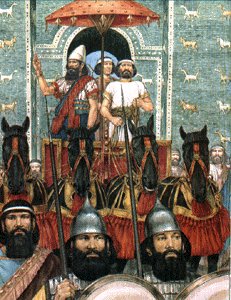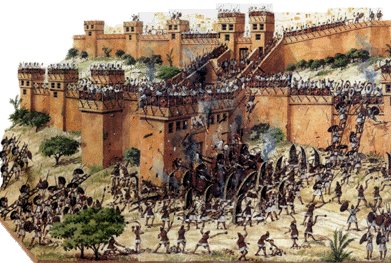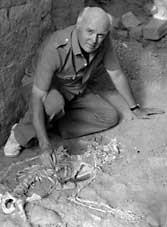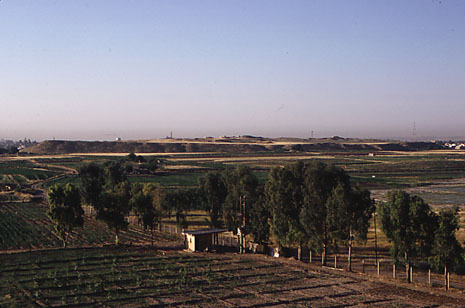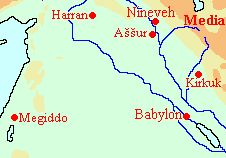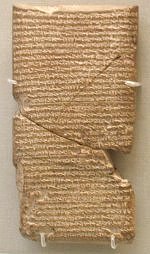- return to Bible Probe
- Visit the Message Board
|
Armed Skeletons Confirm Fall of Nineveh
|
||||||||
They lie
as they fell more than 2,600 years ago, a writhing clump of humanity
frozen in a moment of fearful combat. Pieces of armor, iron daggers,
pikes, and other weapons litter the ground. Buried in the desiccated
leg bone of one of the soldiers is another emblem of blood and pain:
a triple-bladed bronze arrowhead, cunningly shaped to inflict
maximum harm.
This tableau of nine skeletons, recently uncovered in northern Iraq, represents the first clearly documented evidence of an epic story that has been shrouded by centuries of myth and speculation: the downfall of Nineveh, the capital of what was then the world's mightiest empire.
'It's not often that you get such vivid evidence for an event that has been in the consciousness of the world through the Bible and classical sources for such a very long period,' says archaeologist David Stronach of the University of California at Berkeley. 'It's quite remarkable.' 'At its height,
Nineveh was the center of the Assyrian Empire, which dominated
Mesopotamia and the Near East hundreds of years before the rise of
the Roman Empire.
'The city itself, reputedly founded by a great-grandson of Noah, shows evidence of having been inhabited as long ago as 6,000 years. It reached its pinnacle with the reign of Sennacherib, 705- 681 B.C., builder of the fabulous 'Palace Without a Rival.' 'A force for stability and prosperity in the region, the Assyrians constructed arches, tunnels, aqueducts, and the world's first botanical and zoological gardens. The great cuneiform library of the last major monarch, Ashur- bani-pal, preserved for the world the 'Epic of Gilgamesh' and the 'Epic of Creation', two masterpieces that include the story of the Flood. 'But among some of the peoples conquered by the Assyrians, Nineveh and its successive rulers were synonymous with cruelty and repression. The Bible characterizes the approach of the Assyrian host as 'a whirlwind.' 'In a stone pillar, one Assyrian ruler boasted of 'nobles I flayed.' He reported: 'Three thousand captives I burned with fire. I left not one hostage alive. I cut off the hands and feet of some. I cut off the noses, ears and fingers of others. The eyes of numerous soldiers I put out. Maidens I burned as a holocaust.' 'The Hebrew prophet
Zephaniah foretold the fall of Nineveh as the act of a vengeful God:
'He will stretch out his hand against the north, and destroy
Assyria; and he will make Nineveh a desolation, a dry waste like the
desert.'
'First excavation in the mid-19th century by the pioneer English archaeologist Austen Henry Layard, Nineveh is only now yielding the secrets of its final hours. 'I've never seen anything like this mass of tangled bodies with weapons in the midst of them,' says Stronach. 'The desperation of the defense is now manifest.' 'The city was overrun in 612 B.C. by allied forces of Babylonians from southern Iraq and of Medes from Iran. According to Stronach, the conquest may have involved a manipulation of water to flood the city, as mentioned in another Bible passage. 'But Stronach's excavation at one of the city's 15 gates indicates that the final battle included a furious frontal assault, as well. His research was supported in part by the National Geographical Society and Columbia University. 'They may have used water as a weapon at the center of the eastern wall, where the Khosr River winds its way through the city,' says Stronach. 'And to draw away the defenders from that critical point, they may have also assaulted at the opposite ends of the city at the north and south. 'Stronach also found evidence that the city withstood an attack two years before the final fall. After the first attack, the Assyrians appear to have narrowed the width of the city gates from about 20 feet to about 6 feet, so that fewer people could pass through at one time. 'The final battle was
a 'desperate struggle,' Stronach says. 'People fell in the most
extraordinary sort of jumbled poses. I think the mud brick
superstructure of the gate, which was probably burning, collapsed on
them, so they lay buried for the last 2,600 years.'
'The story of the final days of Nineveh is still incomplete. Stronach and his team plan to return to the site this spring. 'There are other bodies there awaiting excavation,' he says, 'we can see their feet and hands emerging. We just don't know how far back within the gate this scene of carnage will continue.' -- Donald Smith, National Geographic News Service.
|
So wrote Byron of the siege of Jerusalem, undertaken by the Assyrian king Sennacherib in 701 B.C. from Nineveh, capital of the greatest empire the world had ever known. For two and one-half millennia, the only known account of this momentous event was in II Kings 18-19, which reports that Sennacherib's invincible army was laid low by the angel of the Lord, after which Sennacherib returned to Nineveh where he was murdered by his sons. Nineveh itself fell to the Medes and Babylonians in 612 B.C., its splendor buried under the shifting dust of northern Mesopotamia. |
Biblical Accuracy
|
See the Chronocle of the Fall of Nineveh here
